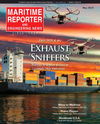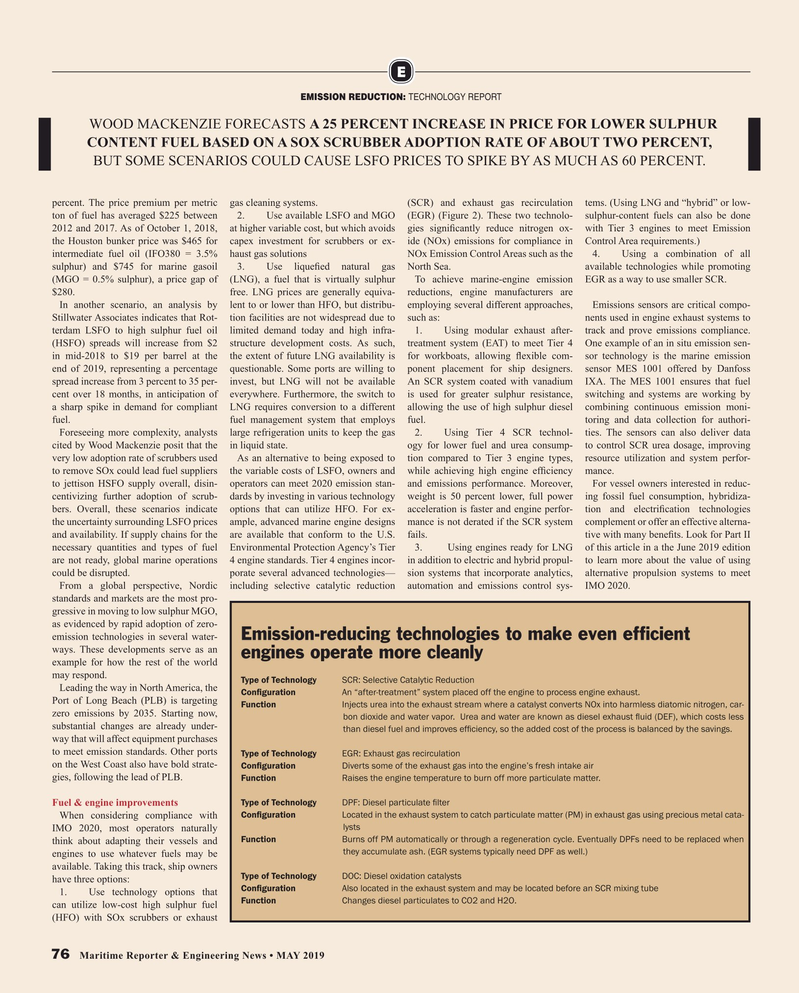
Page 76: of Maritime Reporter Magazine (May 2019)
Propulsion Annual - Green Marine Tech
Read this page in Pdf, Flash or Html5 edition of May 2019 Maritime Reporter Magazine
E
EMISSION REDUCTION: TECHNOLOGY REPORT
WOOD MACKENZIE FORECASTS A 25 PERCENT INCREASE IN PRICE FOR LOWER SULPHUR
CONTENT FUEL BASED ON A SOX SCRUBBER ADOPTION RATE OF ABOUT TWO PERCENT,
BUT SOME SCENARIOS COULD CAUSE LSFO PRICES TO SPIKE BY AS MUCH AS 60 PERCENT. percent. The price premium per metric gas cleaning systems. (SCR) and exhaust gas recirculation tems. (Using LNG and “hybrid” or low- ton of fuel has averaged $225 between 2. Use available LSFO and MGO (EGR) (Figure 2). These two technolo- sulphur-content fuels can also be done 2012 and 2017. As of October 1, 2018, at higher variable cost, but which avoids gies signi? cantly reduce nitrogen ox- with Tier 3 engines to meet Emission the Houston bunker price was $465 for capex investment for scrubbers or ex- ide (NOx) emissions for compliance in Control Area requirements.) intermediate fuel oil (IFO380 = 3.5% haust gas solutions NOx Emission Control Areas such as the 4. Using a combination of all sulphur) and $745 for marine gasoil 3. Use lique? ed natural gas North Sea. available technologies while promoting (MGO = 0.5% sulphur), a price gap of (LNG), a fuel that is virtually sulphur To achieve marine-engine emission EGR as a way to use smaller SCR.
$280. free. LNG prices are generally equiva- reductions, engine manufacturers are
In another scenario, an analysis by lent to or lower than HFO, but distribu- employing several different approaches, Emissions sensors are critical compo-
Stillwater Associates indicates that Rot- tion facilities are not widespread due to such as: nents used in engine exhaust systems to terdam LSFO to high sulphur fuel oil limited demand today and high infra- 1. Using modular exhaust after- track and prove emissions compliance. (HSFO) spreads will increase from $2 structure development costs. As such, treatment system (EAT) to meet Tier 4 One example of an in situ emission sen- in mid-2018 to $19 per barrel at the the extent of future LNG availability is for workboats, allowing ? exible com- sor technology is the marine emission end of 2019, representing a percentage questionable. Some ports are willing to ponent placement for ship designers. sensor MES 1001 offered by Danfoss spread increase from 3 percent to 35 per- invest, but LNG will not be available An SCR system coated with vanadium IXA. The MES 1001 ensures that fuel cent over 18 months, in anticipation of everywhere. Furthermore, the switch to is used for greater sulphur resistance, switching and systems are working by a sharp spike in demand for compliant LNG requires conversion to a different allowing the use of high sulphur diesel combining continuous emission moni- fuel. fuel management system that employs fuel. toring and data collection for authori-
Foreseeing more complexity, analysts large refrigeration units to keep the gas 2. Using Tier 4 SCR technol- ties. The sensors can also deliver data cited by Wood Mackenzie posit that the in liquid state. ogy for lower fuel and urea consump- to control SCR urea dosage, improving very low adoption rate of scrubbers used As an alternative to being exposed to tion compared to Tier 3 engine types, resource utilization and system perfor- to remove SOx could lead fuel suppliers the variable costs of LSFO, owners and while achieving high engine ef? ciency mance.
to jettison HSFO supply overall, disin- operators can meet 2020 emission stan- and emissions performance. Moreover, For vessel owners interested in reduc- centivizing further adoption of scrub- dards by investing in various technology weight is 50 percent lower, full power ing fossil fuel consumption, hybridiza- bers. Overall, these scenarios indicate options that can utilize HFO. For ex- acceleration is faster and engine perfor- tion and electri? cation technologies the uncertainty surrounding LSFO prices ample, advanced marine engine designs mance is not derated if the SCR system complement or offer an effective alterna- and availability. If supply chains for the are available that conform to the U.S. fails. tive with many bene? ts. Look for Part II necessary quantities and types of fuel Environmental Protection Agency’s Tier 3. Using engines ready for LNG of this article in a the June 2019 edition are not ready, global marine operations 4 engine standards. Tier 4 engines incor- in addition to electric and hybrid propul- to learn more about the value of using could be disrupted. porate several advanced technologies— sion systems that incorporate analytics, alternative propulsion systems to meet
From a global perspective, Nordic including selective catalytic reduction automation and emissions control sys- IMO 2020. standards and markets are the most pro- gressive in moving to low sulphur MGO, as evidenced by rapid adoption of zero- emission technologies in several water-
Emission-reducing technologies to make even ef? cient ways. These developments serve as an engines operate more cleanly example for how the rest of the world may respond.
Type of Technology SCR: Selective Catalytic Reduction
Leading the way in North America, the
Con? guration An “after-treatment” system placed off the engine to process engine exhaust.
Port of Long Beach (PLB) is targeting
Function Injects urea into the exhaust stream where a catalyst converts NOx into harmless diatomic nitrogen, car- zero emissions by 2035. Starting now, bon dioxide and water vapor. Urea and water are known as diesel exhaust ? uid (DEF), which costs less substantial changes are already under- than diesel fuel and improves ef? ciency, so the added cost of the process is balanced by the savings.
way that will affect equipment purchases to meet emission standards. Other ports
Type of Technology EGR: Exhaust gas recirculation on the West Coast also have bold strate-
Con? guration Diverts some of the exhaust gas into the engine’s fresh intake air gies, following the lead of PLB.
Function Raises the engine temperature to burn off more particulate matter.
Type of Technology DPF: Diesel particulate ? lter
Fuel & engine improvements
Con? guration Located in the exhaust system to catch particulate matter (PM) in exhaust gas using precious metal cata-
When considering compliance with lysts
IMO 2020, most operators naturally
Function Burns off PM automatically or through a regeneration cycle. Eventually DPFs need to be replaced when think about adapting their vessels and they accumulate ash. (EGR systems typically need DPF as well.) engines to use whatever fuels may be available. Taking this track, ship owners
Type of Technology DOC: Diesel oxidation catalysts have three options:
Con? guration Also located in the exhaust system and may be located before an SCR mixing tube 1. Use technology options that
Function Changes diesel particulates to CO2 and H2O.
can utilize low-cost high sulphur fuel (HFO) with SOx scrubbers or exhaust 76 Maritime Reporter & Engineering News • MAY 2019
MR #5 (74-81).indd 76 MR #5 (74-81).indd 76 5/2/2019 4:08:45 PM5/2/2019 4:08:45 PM

 75
75

 77
77
